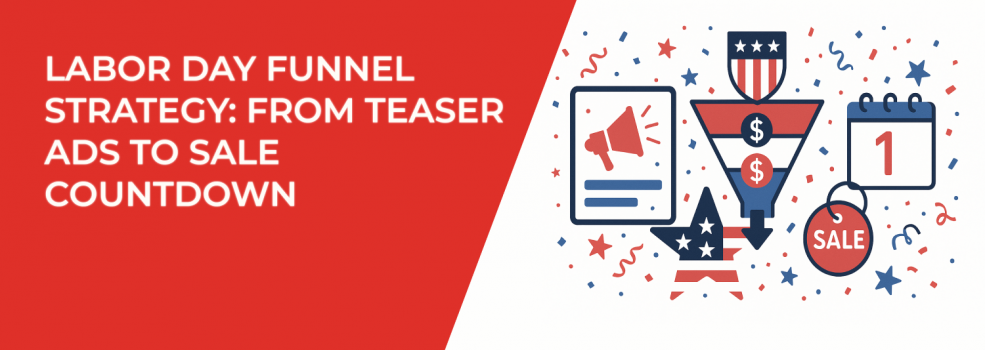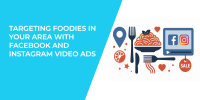Labor Day weekend is one of those rare retail moments when the audience is already in a buying mood. People are expecting deals, scrolling for bargains, and mentally preparing for that seasonal “last chance” to grab summer items before the shift into fall.
But here’s the tricky part — if everyone is running ads at the same time, how do you stand out in a crowded feed? The answer isn’t just bigger discounts. It’s a well-structured funnel that builds anticipation, keeps buyers engaged, and closes with a sense of urgency that’s impossible to ignore.
Below, we’ll map out how to build a Labor Day funnel that does more than sell products. This strategy creates momentum before, during, and after the holiday weekend — and keeps shoppers thinking about your brand long after the sale ends.
Step 1. Teaser Ads That Spark Curiosity
Teasers are about psychology, not just pretty visuals. A good teaser ad doesn’t spill all the details. It whispers a promise.
Beyond the obvious “Big sale coming soon,” here are some subtle but powerful ways to design teasers:
-
Use symbolism instead of product shots. A falling leaf, a calendar page turning, or a clock set to September 1 can trigger curiosity without saying a word.
-
Gamify the wait. Run a poll where users guess what the Labor Day special might be, then retarget participants with the actual reveal. That micro-engagement increases the likelihood they’ll notice your announcement later.
-
Exclude repeat customers who already know your sale patterns. Save your teaser budget for prospects or casual engagers — the ones who need that extra nudge.
The key is restraint. Teasers should feel like the trailer before the movie, not the movie itself.
Step 2. Nurture Interest With Engaging Content
Once curiosity is alive, you can’t let it fade. This stage is where brands either build momentum or lose it.
Instead of just showing product ads, think content-first:
-
Story-driven ads. Share short snippets about why your Labor Day sale matters — maybe it’s about clearing summer stock, maybe it’s framed as a “thank-you” event for loyal customers.
-
Micro-influencers. A small influencer casually hinting about “something exciting happening soon” with your brand can build trust faster than your own teasers.
-
Segmented FAQs. Test running an ad that looks like an FAQ graphic — “When does the sale start? Which categories will be included?” It answers questions directly while still creating anticipation.
This middle layer of your funnel is all about warming people up so they don’t forget you when the rush begins.
Choosing the right creative type can make all the difference here, and this guide to Facebook ad formats shows which ones work best at different funnel stages.
Step 3. Retargeting With Intent
When Labor Day ads flood the market, retargeting becomes the sharp edge that cuts through the noise.
Instead of one-size-fits-all retargeting, think in micro-segments:
-
Price-sensitive browsers. Retarget people who visited low-ticket items with “Under $50 deals.”
-
High-intent visitors. Use dynamic ads that automatically show products they viewed last week — it feels personal without manual setup.
-
Competitor followers. With LeadEnforce, you can create custom audiences from users who follow competitor Facebook groups or Instagram pages. Imagine retargeting someone who just looked at a rival brand’s sale, but showing them yours with a stronger value angle.
This is also the perfect stage to test creative variations. Some audiences respond to bold “Sale ends soon” messaging, while others prefer soft nudges like “Did you see this?” The data will show you which tone wins.
If you’re new to building retargeting flows, here’s a clear walkthrough on how to set up Facebook retargeting effectively so you don’t miss high-intent buyers.
Step 4. The Countdown Effect
Urgency works — but only when it’s fresh. If every ad says “Hurry, time is running out,” people tune out.
Here are a few ways to make your countdown campaigns more persuasive:
-
Stack urgency triggers. Instead of just showing a timer, add scarcity (“Only 200 units left”) or social proof (“1,500 people grabbed this deal yesterday”).
-
Geo-personalization. For local businesses, highlight that your Labor Day deal is exclusive to shoppers in [City] — it makes the sale feel tailored.
-
Switch creative formats daily. Day one can be a carousel, day two a video countdown, day three a bold static graphic. This rotation prevents ad fatigue during the most critical stage.
Urgency shouldn’t feel like shouting. It should feel like a final reminder from a brand that’s been consistently present all week.
Be careful though — overusing countdown-style messaging can lead to ad fatigue. This article on how to spot and fix ad fatigue on Facebook breaks down the warning signs.
Step 5. Post-Sale Follow-Up
Here’s where most advertisers drop the ball. Labor Day ends, campaigns stop, and the audience goes cold.
But your funnel doesn’t have to end there. Try these less obvious tactics:
-
Reframe the leftover buzz. Run a “Thank you for shopping” campaign that doubles as a soft upsell: “If you missed out, here are year-round favorites still available.”
-
Harvest audiences for Q4. Everyone who clicked, viewed, or bought during Labor Day is now primed for Black Friday. Tag them in your CRM for future targeting.
-
Turn reviews into ads. Encourage new buyers to leave quick feedback, then run retargeting ads using those fresh testimonials to strengthen social proof ahead of your next sale cycle.
If you treat Labor Day as just one funnel in a larger seasonal strategy, each campaign becomes more efficient than the last.
Extra Tips to Go Beyond the Obvious
Small adjustments can create big wins. Here are some less obvious ways to refine your Labor Day funnel and squeeze out more performance.
Run a Pre-Funnel Test
Don’t wait until the holiday weekend to discover what works. Two weeks before Labor Day, set aside a small testing budget. Create two or three ad variations — maybe a static teaser image, a short video, and a carousel. Run them to a limited audience and see which format gets the best engagement rate.
The winning creative becomes your hero ad during the main campaign. This way, you avoid wasting budget on underperforming ads when competition (and CPMs) are at their peak. Think of it as a dress rehearsal before the real performance.
If you’re unsure what to test first, whether creative, copy, or audience, check this guide: what to test first in Facebook campaigns. It’ll save you time and budget.
Time Ads to Behaviors
Not all shoppers behave the same way throughout the weekend. Some browse early in the morning, others shop after work, and many stay up late for “last chance” deals.
Leverage this by scheduling your ads around behavioral patterns:
-
Teaser ads early mornings — when people casually scroll before starting their day.
-
Countdown ads late at night — urgency feels sharper when people are about to close their screens.
-
Retargeting reminders midday — when shoppers are on lunch breaks or doing quick product checks.
This small adjustment makes your funnel feel perfectly timed to your audience’s habits rather than random placements in their feed.
Silent Scarcity
Urgency doesn’t always need a loud headline. In fact, subtle scarcity often feels more authentic and believable. Instead of blasting “Sale almost gone” across every creative, reflect scarcity through design and product updates.
For example:
-
Show a product grid with fewer color swatches available.
-
Add “Only 2 left” badges to high-demand items.
-
Display empty shelves or faded-out product images to signal stock depletion.
Shoppers pick up on these cues without feeling pressured. That quiet signal can sometimes drive more conversions than an overused “Hurry now” banner.
Don’t Overlook Organic
While paid ads carry the funnel, organic content plays a critical supporting role. A simple Instagram Story with a poll (“Which color would you grab on sale?”) can prime audiences to notice your paid campaigns later. A behind-the-scenes clip of your team packing orders can create relatability that makes your ads feel less transactional.
Also, organic posts give you extra opportunities to retarget. Anyone who watches your Stories or interacts with your feed becomes eligible for custom audience ads — a quick, low-cost way to expand your funnel.
Why These Small Moves Matter
Sometimes the difference between a mediocre campaign and a high-performing one isn’t the budget — it’s the details. Pre-funnel testing sharpens your creative. Behavioral timing matches intent. Silent scarcity creates trust. Organic content makes your ads feel more human.
Put together, these optimizations ensure that when shoppers see your Labor Day campaign, it doesn’t feel like just another sale — it feels like a well-timed, carefully thought-out offer that deserves attention.
Final Thoughts
Labor Day is more than a sale window. It’s a test of how well your funnel can move audiences from curiosity to urgency to loyalty. The teaser creates buzz. The engagement stage builds trust. Retargeting makes it personal. The countdown pushes action. And the post-sale follow-up turns one-time shoppers into repeat customers.
If you put real thought into each stage, you won’t just sell more over Labor Day weekend — you’ll sharpen a funnel strategy that works every time a seasonal event comes around.

